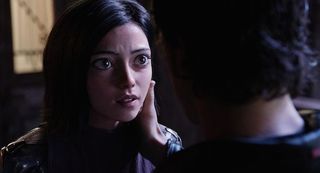How Alita: Battle Angel Star Rosa Salazar Used Groundbreaking Mo-Cap Effects To Create Her Character

At the kickoff of this year's South By Southwest film festival, 20th Century Fox took advantage of a rare opportunity. With the eyes of the film world on Austin Texas, Fox opened the doors to Robert Rodriguez's Austin-based Troublemaker Studios, and used the event as a means to tease the upcoming and hotly anticipated Alita: Battle Angel. Rodriguez (Sin City, Desperado, Spy Kids) inherited the adaptation of Alita from James Cameron, who had been tinkering with Yukito Kishiro's graphic novel Gunnm for years.
We saw new footage from Alita: Battle Angel -- due in theaters in December -- then spent time with leading lady Rosa Salazar, who opened up about the motion-capture technology that is being used to bring her character, Alita, to life. In the unfinished footage that we watched, Salazar wears the facial dots and camera harnesses that Robert Rodriguez relies on to capture her performance, so that WETA can translate it to a character in post. When I asked Salazar (Parenthood, Maze Runner: The Death Cure) if she ever got used to the mo-cap harness, she explained:
When you're in a scene with someone, it all melts away. I know that sounds kind of unbelievable, but it does! When you take a restroom break, it doesn't melt away. Because you are sitting there with a helmet on and two cameras pointed straight at your face, and you're just trying to pee. In those moments, it doesn't really... you're like, 'this is pretty extraordinary.' But it's just learning a new set of skills. It's just learning a new language, and I always want to do films that test my limits that way, and push me to find a new method of doing things.
We have seen motion-capture make leaps and bounds, particularly in the Planet of the Apes series that's also housed at Fox. Andy Serkis and the wizards at WETA are working on an annual basis to perfect the techniques that can bring a character like Caesar, or like Alita for Robert Rodriguez, to life on screen. One challenge for Rosa Salazar, though, was the fact that because WETA has to work on her look, she can't get an instant gratification of watching clean playback from her daily performance. When I asked her about that obstacle, she found a silver lining, elaborating:
On the one hand, it frees you from doing a nosedive into insecurity land, where you start to pick apart your own performance. You're an actress. You're too close to it. You're not the director. That can be a little bit dangerous, the territory of playback watching. But here, you watch playback, and you can actually see a digital version of Alita and her face. A very raw rendering, but you can see how things are going to move. It takes you out of the 'How's it going to be? How's it going to look?' zone and it puts your into, 'Oh, OK, if I'm going to move my hand this way, I need to move it all the way back.' Because to translate your actual physical movements into that conduit, you just have to figure that out. You're really just interested in the process. It's an all-new process.
See Rosa Salazar as Alita in the first trailer for Alita: Battle Angel:
Robert Rodriguez's Alita: Battle Angel will be in theaters on December 21. I will have more from CinemaBlend's Troublemaker Studios visit in the coming days, and even more reaction to the footage as the film gets closer. In the meantime, bookmark our 2018 Movie Release Calendar to keep track of all the great films reaching theaters this year.
CINEMABLEND NEWSLETTER
Your Daily Blend of Entertainment News

Sean O’Connell is a journalist and CinemaBlend’s Managing Editor. Having been with the site since 2011, Sean interviewed myriad directors, actors and producers, and created ReelBlend, which he proudly cohosts with Jake Hamilton and Kevin McCarthy. And he's the author of RELEASE THE SNYDER CUT, the Spider-Man history book WITH GREAT POWER, and an upcoming book about Bruce Willis.
Most Popular




